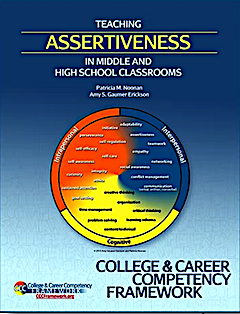Add Assertiveness to Tweens’ Communication
By Dr. Pattie Noonan and Dr. Amy Gaumer Erickson

Amy and Pattie
Do your students ask for help when they need it? Do they know how to resist peer pressure? Do they respectfully express their thoughts and feelings when they disagree with friends or educators?
Many of your students may struggle with expressing themselves while respecting and empathizing with others. There are things we can do to help our students learn to be more assertive.
Assertiveness is the ability to express your wants, needs, and thoughts in a self-assured, direct manner while respecting what others want, need, and think (Noonan & Gaumer Erickson, 2018, p. 105). This 3-minute video introduces the concept of assertiveness, its definition, and some examples of how to support the development of assertiveness at school and home.
When middle school students are either too passive or communicate too aggressively, they likely cannot communicate respectfully through assertiveness. Learning specific assertiveness skills can help them express their thoughts and feelings more effectively, build better friendships and relationships over time, and feel more connected to the people in their lives.
Being assertive means that they can speak up for themselves and others, even when it is difficult. Whether it is helping your students learn to ask for help, resist peer pressure, or work through conflict with a friend, the ability to assert themselves enables adolescents to express their wants, needs, and thoughts respectfully.
Listen as McKenzie, a high school senior, explains assertiveness and shares how she was assertive with her supervisor at work.
Understanding assertiveness requires understanding how passive, aggressive, and assertive communication styles differ. Unfortunately, many students are unaware of the differences between these styles and confuse assertiveness with aggressiveness. As educators, we want our students to identify these communication styles in others, but most importantly, in themselves.
Listen as Dr. Pattie Noonan introduces assertiveness to parents and discusses the three types of communication. As you listen, think about how you might help your students identify these types of communication in your classroom.
Previously, McKenzie shared that assertiveness means expressing your wants, needs, and thoughts while respecting others’ wants, needs, and thoughts. Part of effectively expressing ourselves is identifying what we are feeling and why and respectfully communicating those feelings. As a result, we can help students explore and better understand their emotions.
Dr. Noonan shares one way to help teenagers describe the emotions they are experiencing. By understanding our feelings, we are better able to control how we act on and communicate those feelings. Think about how you could support your students to identify feelings for a specific situation by encouraging them to determine the more complex emotions on the outer two rings of the Feeling Words Wheel.
Listen to Declan, a high school student, as he describes everyday situations where students might use the Feeling Words Wheel and need to exercise empathy. As you listen, consider occasions when it might be helpful to use the Feeling Words Wheel to help your students express themselves while empathizing with others.
Communicating assertively might seem difficult at first. In this five-minute video, Dr. Noonan suggests teaching teenagers to use a three-part statement. Using this recipe, students can communicate their wants, needs, and thoughts while respecting what others want, need, and think.
Knowing how and when to be assertive
No one is assertive in every interaction, but giving students practice using a three-part assertive statement can help ensure that they know how to do so when they need to be assertive. Dr. Noonan also discusses setting personal boundaries. These protective assertions promote healthier relationships and limit your student’s chances of doing things they may regret.
Noonan and Gaumer Erickson wrote Helping Middle Level Students Self-Regulate earlier at MiddleWeb. Reviews of their books at MiddleWeb appear here.
References
Noonan, P. M., & Erickson, A. S. G. (2018). The skills that matter: Teaching interpersonal and intrapersonal competencies in any classroom. Corwin.

Dr. Pattie Noonan is an associate research professor at the University of Kansas where she centers her work on providing and evaluating professional development related to social emotional learning. She holds a firm belief in the capacity of all students to become socially and emotionally engaged, career equipped, lifelong learners. Much of her work entails providing schoolwide professional development and coaching to educators, counselors, trainers, and instructional coaches, while working in close collaboration with leadership. She is the co-author of The Skills That Matter: Teaching Intrapersonal and Interpersonal Competencies in Any Classroom and Teaching Self-Regulation: Seventy-Five Instructional Activities to Foster Independent, Proactive Students.
Dr. Amy Gaumer Erickson is an associate research professor at the University of Kansas and co-author of The Skills That Matter: Teaching Intrapersonal and Interpersonal Competencies in Any Classroom and Teaching Self-Regulation: Seventy-Five Instructional Activities to Foster Independent, Proactive Students. Her practice-based research focuses on the implementation of interpersonal and intrapersonal competency instruction within a Multi-Tier System of Supports (MTSS), guiding educators to embed competency instruction within content-area coursework and evaluate students’ social-emotional growth. Gaumer Erickson has taught at the middle and high school levels in urban, suburban, charter and alternative schools.

































